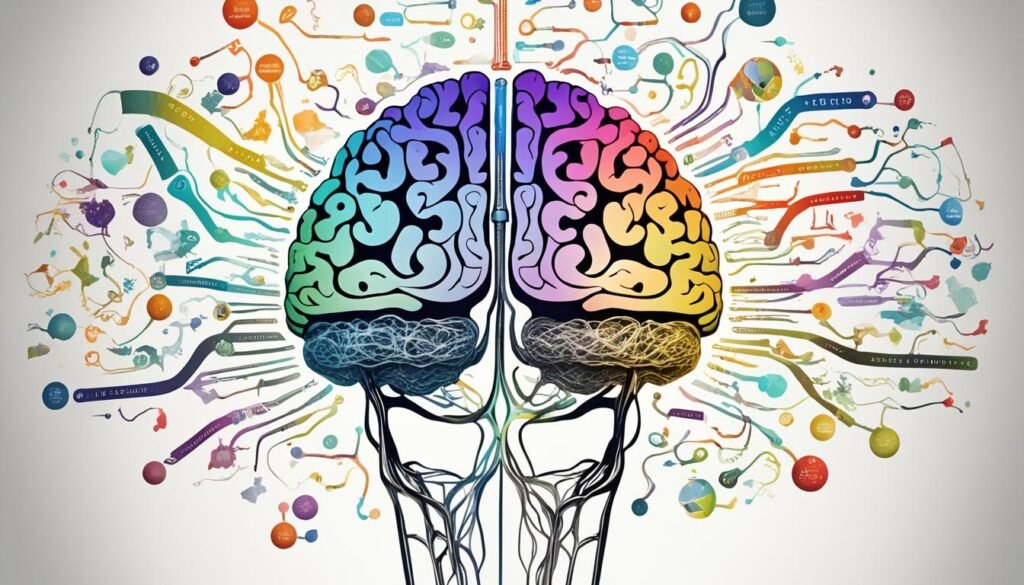In today’s dynamic educational landscape, staying ahead requires a commitment to continuous learning and professional development. Embracing cutting-edge learning methods is crucial for acquiring new skills, expanding knowledge, and keeping pace with the rapidly evolving world around us.
Advancements in technology and research have given rise to innovative and effective approaches to learning. These cutting-edge methods not only accelerate knowledge acquisition but also enhance critical thinking, problem-solving, and adaptability.
Whether you are a student, a working professional, or an individual seeking personal growth, embracing new learning methods can help you unlock your full potential and thrive in today’s ever-changing educational landscape.
Key Takeaways:
- Continuous learning and professional development are essential for success in today’s rapidly evolving educational landscape.
- Cutting-edge learning methods leverage technology and research to accelerate knowledge acquisition and enhance critical skills.
- Embracing new learning methods can lead to personal and professional growth, empowering individuals to adapt to change and achieve their goals.
Understanding Cutting-Edge Technology
When we talk about cutting-edge technology, we refer to the revolutionary advancements that propel us beyond traditional methods. These innovations introduce groundbreaking concepts, continuously evolve, and often disrupt industries by enhancing efficiency. From healthcare to transportation and communication, cutting-edge technologies have transformed various sectors. Embracing these advancements is crucial for staying ahead in our ever-changing world.
In today’s fast-paced society, advancements in technology have become synonymous with progress and innovation. With each passing day, new technologies emerge, pushing the boundaries of what we thought was possible. Cutting-edge technology has the power to reshape industries, revolutionize processes, and drive unprecedented growth.
“Cutting-edge technology is the catalyst that propels us into the future, making the unimaginable a reality.”
Companies and individuals who embrace cutting-edge technology are at the forefront of change. They have the opportunity to harness new possibilities, increase productivity, and gain a competitive edge. By leveraging these technological advancements, they can optimize operations, enhance customer experiences, and explore new horizons.
Nowadays, healthcare is a prime example of how cutting-edge technology is making a significant impact. From artificial intelligence and machine learning algorithms that assist in disease diagnosis to telemedicine platforms that provide remote care, advancements in this field have improved patient outcomes and revolutionized the delivery of healthcare services.
Another industry that has been disrupted by cutting-edge technology is transportation. The rise of electric vehicles, autonomous vehicles, and ride-sharing apps have transformed the way we travel, making transportation more sustainable, convenient, and efficient.
Moreover, in the realm of communication, cutting-edge technology has bridged the gap between people and nations. With the advent of 5G networks, IoT devices, and virtual reality, we can now connect and collaborate effortlessly, blurring the lines between physical and digital realms.
| Industry | Examples of Cutting-Edge Technologies |
|---|---|
| Healthcare | Artificial intelligence, telemedicine, wearable devices |
| Transportation | Electric vehicles, autonomous vehicles, ride-sharing platforms |
| Communication | 5G networks, Internet of Things, virtual reality |
Cutting-edge technology isn’t just a buzzword; it’s a driving force behind societal progress. By understanding and embracing these advancements, we have the opportunity to shape the future and pave the way for a new era of innovation and disruption.
Benefits of Cutting-Edge Technology

Cutting-edge technology offers numerous benefits across various industries. Embracing these advancements can lead to increased efficiency and productivity through automation and data analysis. By leveraging cutting-edge technology, businesses can streamline processes and optimize resource allocation, resulting in improved operational performance.
Furthermore, cutting-edge technology enhances safety and security by incorporating advanced cybersecurity measures and instrumentation. Robust security protocols protect sensitive data from unauthorized access, ensuring the integrity and confidentiality of information. Additionally, technologies such as biometrics and surveillance systems enhance physical safety, fostering a secure environment for employees and stakeholders.
Moreover, cutting-edge technology elevates user experiences by employing interactive UI/UX design and personalized features. Intuitive interfaces and seamless interactions enhance user satisfaction and engagement, enabling businesses to gain a competitive edge. Personalization capabilities also allow companies to tailor their offerings to individual preferences, providing a personalized experience that meets customer expectations.
This integration of cutting-edge technology paves the way for innovation and growth. By embracing new business models and tapping into untapped markets, organizations can expand their reach and seize opportunities for revenue expansion. The dynamic nature of cutting-edge technology spurs innovation, enabling companies to develop revolutionary products and services that disrupt industries and capture market share.
As technology continues to evolve, staying at the forefront of cutting-edge advancements is crucial for businesses seeking sustained growth in today’s highly competitive landscape. By leveraging the benefits of cutting-edge technology, companies can optimize efficiency, enhance security measures, improve user experiences, and unlock new avenues for innovation and growth.
Benefits of Cutting-Edge Technology
| Benefit | Description |
|---|---|
| Efficiency | Automation and data analysis capabilities streamline processes, optimizing resource allocation and operational performance. |
| Productivity | Advanced technologies enable employees to accomplish tasks more efficiently, increasing overall productivity. |
| Safety | Cutting-edge security measures, such as biometrics and surveillance systems, ensure employee and data safety. |
| Security | Robust cybersecurity protocols protect sensitive data from unauthorized access, ensuring confidentiality and integrity. |
| User Experience | Interactive UI/UX design and personalized features enhance user satisfaction and engagement. |
| Innovation | Cutting-edge technology drives innovation, leading to the development of revolutionary products and services. |
| Growth | By embracing new business models and market expansion, organizations can achieve sustainable growth. |
Examples of Cutting-Edge Technologies

Cutting-edge technologies play a pivotal role in shaping our world, revolutionizing industries, and pushing the boundaries of what’s possible. Here are some remarkable examples:
Artificial Intelligence (AI) and Machine Learning (ML)
Artificial intelligence and machine learning replicate human intelligence in machines, enabling them to perform complex tasks, analyze vast amounts of data, and make informed decisions. AI and ML have transformed various sectors, such as healthcare, finance, and e-commerce, by improving efficiency, accuracy, and productivity.
Internet of Things (IoT)
The Internet of Things connects physical devices, sensors, and systems to the internet, creating a network where they can communicate and share data. This technology has revolutionized industries like home automation, transportation, and manufacturing. IoT enables seamless connectivity and smart automation, making processes more efficient and enhancing data-driven decision-making.
Virtual Reality (VR) and Augmented Reality (AR)
Virtual reality immerses users in a simulated environment, while augmented reality overlays digital elements onto the real world. VR and AR have revolutionized gaming, entertainment, and training industries. They offer unprecedented immersive experiences, empowering industries like tourism, education, and architecture to provide virtual walkthroughs, interactive training simulations, and enhanced consumer engagement.
Blockchain
Blockchain is a decentralized and transparent digital ledger that records transactions across multiple computers. It ensures security, transparency, and immutability, making it ideal for applications such as digital currencies, supply chain management, and smart contracts. Blockchain technology has the potential to transform industries by streamlining operations, reducing fraud, and enabling trustless transactions.
Robotics and Automation
Robotics and automation involve the development and implementation of machines and systems that can perform tasks with minimal human intervention. They are revolutionizing manufacturing, logistics, and agriculture industries by improving efficiency, accuracy, and safety. From self-driving cars to robotic surgery, these technologies are reshaping the way we work and live.
Biotechnology
Biotechnology encompasses the use of living organisms or biological systems to develop innovative products, improve agriculture, and advance medical treatments. It plays a crucial role in areas like genetic engineering, drug development, and sustainable farming practices. Biotechnology has the potential to address global challenges in healthcare, food security, and environmental sustainability.
| Technology | Industry Impact |
|---|---|
| Artificial Intelligence (AI) and Machine Learning (ML) | Improved efficiency, personalized recommendations, predictive analytics |
| Internet of Things (IoT) | Smart home automation, enhanced supply chain management, connected healthcare devices |
| Virtual Reality (VR) and Augmented Reality (AR) | Immersive gaming experiences, interactive training simulations, virtual tourism |
| Blockchain | Secure and transparent transactions, decentralized finance, supply chain traceability |
| Robotics and Automation | Increased productivity, precision manufacturing, autonomous vehicles |
| Biotechnology | Advanced medical treatments, genetically modified crops, sustainable biofuels |
These cutting-edge technologies continue to evolve and redefine possibilities, promising a future where innovation transforms the way we live, work, and connect.
Impacts of Cutting-Edge Technology on Industries
Cutting-edge technology has revolutionized various industries, including healthcare, education, and customer service. The integration of advanced technology has brought about significant improvements in efficiency, effectiveness, and overall operations.
Healthcare
In the healthcare industry, cutting-edge technology has transformed patient care and treatment outcomes. Advanced medical equipment and digital systems have streamlined processes, enabling healthcare professionals to provide better care and precise diagnoses. The use of electronic health records has improved the management of patient information, ensuring accessibility and data accuracy. Additionally, technology has facilitated telemedicine, enabling remote consultations and expanding access to healthcare services.
Education
When it comes to education, the impacts of cutting-edge technology are wide-ranging. Innovative learning platforms and digital resources have enhanced learning experiences for students, making education more engaging, interactive, and personalized. Technology has also facilitated administrative tasks, such as online registration and grading systems, simplifying processes for educators and institutions. Furthermore, special education programs and tools equipped with multi-tiered systems of support (MTSS) based on ADA Section 504 guidelines have improved inclusivity and accessibility for students with diverse learning needs.
Customer Service
Customer service has greatly benefited from cutting-edge technology as well. Efficient software and advanced systems have revolutionized customer support, enabling businesses to provide prompt and personalized assistance. Customer relationship management (CRM) platforms help manage customer information, track interactions, and streamline communication, resulting in improved customer satisfaction and loyalty. Additionally, technology has facilitated self-service options, such as chatbots and online FAQs, empowering customers to find solutions independently.
Medicaid Reimbursement
For government programs like Medicaid, cutting-edge technology has streamlined reimbursement processes. Software applications and systems tailored for Medicaid reimbursement help healthcare providers accurately track and manage claims, ensuring timely and accurate reimbursement. These technologies automate administrative tasks, reduce errors, and improve efficiency, ultimately benefiting both healthcare practitioners and patients.
Overall, the impacts of cutting-edge technology on various industries are significant. From enhancing patient care and transforming education to improving customer service and streamlining reimbursement processes, advanced technologies continue to shape and improve the way we work and live.
The Role of Cutting-Edge Technology in Learning

Cutting-edge technology plays a vital role in online learning and skill development. With the rise of digital platforms, individuals now have access to a vast array of study materials, training programs, and educational resources at their fingertips.
Online learning platforms have revolutionized the way we acquire knowledge and develop new skills. They offer convenient and flexible options for learners of all backgrounds, allowing them to access learning materials whenever and wherever they choose. Whether it’s a course on programming, graphic design, or management, these platforms provide comprehensive training programs tailored to meet the diverse needs of learners.
One of the key advantages of online learning is the ability to engage in professional development on an ongoing basis. Professionals can enhance their skill sets and stay abreast of the latest industry trends through virtual workshops, webinars, and interactive courses. These platforms also foster a sense of lifelong learning, empowering individuals to continually update their knowledge and adapt to the evolving demands of the workplace.
Moreover, cutting-edge technology enables a truly personalized learning experience. Learners can choose from a wide range of courses and customize their learning journey to suit their preferences and goals. The interactive nature of online learning platforms promotes engagement and active participation, enhancing the overall learning experience.
Online learning platforms provide access to study materials, training programs, and educational resources, supporting professional development and lifelong learning.
This integration of technology and learning has transformed traditional education models. It has paved the way for more accessible and inclusive education, transcending geographical barriers and offering opportunities to individuals who may not have otherwise had access to quality education.
In conclusion, cutting-edge technology has revolutionized the way we learn and develop skills. Online learning platforms have democratized access to education and provided a wealth of resources for skill development and knowledge acquisition. By embracing these technologies, individuals can embark on a journey of lifelong learning and continual growth in an ever-changing world.
The Science of Learning

Understanding the science of learning is crucial for effective teaching and learning practices. It involves cognitive skills, information processing, and the various learning processes that occur in the brain. By delving into psychological science and research-based approaches, educators gain valuable insights into how people learn and solve problems.
One essential aspect of learning is the development of cognitive skills. These skills encompass a range of mental abilities, such as attention, memory, reasoning, and problem-solving. Cognitive skills play a pivotal role in processing information, understanding concepts, and acquiring new knowledge.
Information processing is another key aspect of the science of learning. It involves how individuals take in, organize, store, and retrieve information. A deeper understanding of information processing can enable educators to design learning experiences that optimize retention and retrieval.
“Research-based approaches provide valuable insights into effective teaching and learning practices.”
Psychological science, which focuses on the study of thoughts, feelings, and behaviors, contributes significantly to the science of learning. Researchers investigate the psychological aspects of learning, including motivation, attentional processes, and memory formation. By applying these findings, educators can create engaging and impactful learning environments.
An essential element in the science of learning is problem-solving. Problem-solving skills are crucial for navigating real-life situations and applying knowledge to novel challenges. By incorporating problem-solving activities into educational practices, educators enhance students’ ability to analyze, strategize, and find creative solutions.
Experiential learning is a practical, hands-on approach that fosters deep understanding and skill acquisition. This learning method immerses students in real-world experiences, allowing them to learn through active engagement and reflection. Experiential learning has been shown to enhance knowledge retention and application.
Neuroscience, the study of the nervous system and brain, further expands our understanding of the learning process. By examining brain function and neural pathways, researchers uncover insights into how the brain encodes, consolidates, and retrieves information. Applying neuroscience principles to education can lead to more effective instructional strategies and personalized learning experiences.
By embracing the science of learning and drawing from cognitive skills, information processing, psychological science, problem-solving, experiential learning, research-based approaches, and neuroscience, educators can optimize teaching methods and enhance students’ ability to learn and succeed.
Key Takeaways
- The science of learning encompasses cognitive skills, information processing, psychological science, problem-solving, experiential learning, research-based approaches, and neuroscience.
- Cognitive skills are mental abilities essential for processing information, understanding concepts, and acquiring knowledge.
- Information processing involves how individuals take in, organize, store, and retrieve information.
- Psychological science provides insights into motivation, attention, and memory, contributing to effective teaching and learning practices.
- Problem-solving skills enable individuals to analyze, strategize, and find creative solutions to challenges.
- Experiential learning immerses students in real-world experiences, facilitating deep learning and skill acquisition.
- Neuroscience studies brain function and neural pathways, informing instructional strategies and personalized learning approaches.
The Science of Learning Components
| Cognitive Skills | Information Processing | Psychological Science | Problem-Solving | Experiential Learning | Neuroscience |
|---|---|---|---|---|---|
| Attention | Encoding | Motivation | Analytical Thinking | Active Engagement | Brain Function |
| Memory | Storage | Attentional Processes | Creative Thinking | Reflection | Neural Pathways |
| Reasoning | Retrieval | Memory Formation | Problem-Solving Skills |
Innovative Learning Methods

With the rapid advancement of cutting-edge technology, innovative learning methods have emerged, revolutionizing the way we acquire knowledge and develop new skills. These methods seamlessly integrate technology into the learning process, creating engaging and interactive experiences for learners of all ages and backgrounds. Let’s explore some of the most impactful and exciting techniques that are shaping the future of education.
Adaptive Learning
Adaptive learning is a groundbreaking approach that tailors instruction to meet the unique needs and progress of individual learners. By leveraging data analytics and machine learning algorithms, adaptive learning platforms continuously assess a learner’s performance and adapt the content and pace of instruction accordingly. This personalized approach ensures that learners receive targeted support, allowing them to maximize their learning potential.
Game-Based Learning
Game-based learning brings the element of play into the educational setting, effectively engaging learners and enhancing their motivation to acquire knowledge. By incorporating gamification elements such as challenges, rewards, and interactive simulations, game-based learning transforms traditional lessons into immersive and interactive experiences. This approach promotes problem-solving, critical thinking, and collaboration skills, making learning enjoyable and impactful.
Multimedia
Using multimedia in education involves integrating various forms of media, like images, videos, animations, and audio, to enhance the understanding and retention of information. By appealing to multiple senses, multimedia stimulates cognitive engagement and facilitates comprehension. Learners can visualize complex concepts, observe real-world examples, and interact with interactive visuals, resulting in a deeper and more meaningful learning experience.
Experiential Learning
Experiential learning takes a hands-on approach, allowing learners to actively participate in real-world scenarios and apply their knowledge in practical contexts. This approach emphasizes reflection, problem-solving, and critical thinking skills, as learners learn by doing and reflecting on their experiences. Experiential learning promotes a deeper understanding and long-term retention of concepts, making it an effective method for developing practical skills.
Personalized Instruction
Personalized instruction recognizes that learners have different preferences, strengths, and learning styles. By tailoring learning experiences to individual needs, this method ensures that learners receive instruction at their own pace and in a way that resonates with them. Personalized instruction can include adaptive technologies, differentiated activities, and individualized learning paths. This approach empowers learners to take ownership of their learning journey and fosters a sense of autonomy and motivation.
Interactive Lessons
Interactive lessons promote active engagement and participation by creating opportunities for learners to interact with the content and each other. This can include discussions, group work, hands-on projects, and online collaboration. Interactive lessons encourage critical thinking, problem-solving, and communication skills while fostering a sense of community and collaboration among learners. Through interactivity, learners actively construct their knowledge and deepen their understanding of the subject matter.
By embracing these innovative learning methods, educators and learners can harness the power of cutting-edge technology to create dynamic and effective learning experiences. Whether it’s personalizing instruction, incorporating gamification, or using multimedia resources, these methods have the potential to revolutionize education, making it more engaging, meaningful, and impactful for learners of all ages.
The Importance of Lifelong Learning

Lifelong learning plays a crucial role in today’s rapidly changing world. It goes beyond traditional education and involves acquiring knowledge and skills throughout one’s life, fostering personal and professional growth. Lifelong learning allows individuals to adapt to new technologies, industries, and societal changes, ensuring ongoing success and fulfillment.
One of the key benefits of lifelong learning is knowledge acquisition. By actively seeking new information and experiences, individuals expand their understanding of the world around them. This continuous learning process equips them with the latest insights and perspectives, enabling them to navigate complex challenges and make informed decisions.
Self-improvement is another significant aspect of lifelong learning. By engaging in continuous learning, individuals can identify their strengths and weaknesses, seeking opportunities to develop new skills and improve existing ones. Through self-improvement, they enhance their capabilities, boost their confidence, and open doors to new possibilities.
Continuing education is a vital component of lifelong learning. It involves participating in formal or informal educational activities to deepen knowledge in a specific field or explore new areas of interest. Continuing education keeps individuals up-to-date with the latest advancements, ensuring they remain competitive in their professions.
Furthermore, lifelong learning supports skill-building. It enables individuals to acquire and refine essential skills, such as critical thinking, problem-solving, and communication. These skills are highly valued in today’s dynamic and competitive job market, equipping individuals with the tools they need for professional success.
“Education is not preparation for life; education is life itself.” – John Dewey
Lifelong learning is not confined to a particular age or stage of life. It encourages a mindset of growth and curiosity, inspiring individuals to continuously seek new knowledge and experiences. Whether through formal education, online courses, workshops, or self-study, lifelong learning provides endless opportunities for personal and professional development.
Benefits of Lifelong Learning:
- Enhanced knowledge and understanding of the world
- Improved self-confidence and personal growth
- Increased adaptability to changing technologies and industries
- Expanded career opportunities through continuing education
- Development of essential skills for success
Embracing lifelong learning ensures that individuals remain intellectually engaged, adaptable, and resilient in an ever-evolving world. It empowers them to pursue their passions, achieve their goals, and lead fulfilling lives. As the saying goes, “Education is not preparation for life; education is life itself.”
Strategies for Effective Learning

Effective learning strategies are key to enhancing the learning process and improving retention. By implementing these strategies, learners can optimize their study sessions and facilitate a deeper understanding of the material. Here are some techniques, resources, and practices that promote effective learning:
1. Study Techniques
Utilize study techniques that cater to your individual learning style. This can include techniques such as:
- Summarization: Condensing complex information into concise summaries.
- Mnemonic Devices: Creating memory aids like acronyms or rhymes to remember key concepts.
- Visualization: Creating mental images or diagrams to aid in understanding.
2. Study Resources
Make use of a variety of study resources to supplement your learning. These can include:
- Textbooks: Comprehensive learning materials that cover the subject matter.
- Online Courses: Internet-based courses that provide structured learning experiences.
- Tutoring: Seeking guidance from knowledgeable individuals or experts in the field.
3. Problem-Solving and Critical Thinking
Developing problem-solving and critical thinking skills enhances your ability to analyze information, evaluate different perspectives, and arrive at logical conclusions. Engage in activities that promote these skills, such as:
- Case Studies: Analyzing real-world scenarios and proposing solutions.
- Debate: Engaging in discussions that require critical analysis and reasoning.
- Brainstorming: Generating creative solutions to challenges or problems.
4. Retrieval Practice
Retrieval practice involves actively recalling information from memory, reinforcing the learning process and improving long-term retention. Incorporate retrieval practice into your study routine by:
- Flashcards: Using flashcards to recall key facts, definitions, or concepts.
- Quizzes: Testing your understanding of the material through quizzes or self-assessments.
- Teaching Others: Explaining concepts to someone else to reinforce your own knowledge.
5. Active Learning
Engage in hands-on activities and interactive experiences to promote active learning. This can involve:
- Group Discussions: Collaborating with peers to solve problems or discuss ideas.
- Experiments: Conducting experiments to apply theoretical knowledge.
- Role-Playing: Simulating real-life scenarios to practice skills or decision-making.
“Learning is not a spectator sport. Students do not learn much just by sitting in class listening to teachers, memorizing pre-packaged assignments, and spitting out answers.” – Carl Rogers
By incorporating these strategies into your learning journey, you can optimize your study sessions, improve retention, and enhance your overall learning experience.
Overcoming Challenges in Learning

Learning can present challenges for individuals with different abilities and diverse learning needs. However, with personalized instruction and inclusive education, these difficulties can be addressed and overcome. By implementing appropriate learning strategies, providing accommodations, and fostering a supportive learning environment, we can ensure the success of all learners.
Inclusive education plays a significant role in addressing the needs of diverse learners. It emphasizes the importance of providing equal opportunities for all students, regardless of their abilities or backgrounds. Through inclusive practices, we create an environment that celebrates diversity and promotes the inclusion of all learners.
Personalized instruction is another crucial aspect of overcoming learning challenges. By tailoring instruction to meet the specific needs and learning styles of individual students, we can maximize their potential. Personalized instruction recognizes that every learner is unique and requires different approaches to maximize their learning experience.
Learning difficulties can arise in various forms, including specific learning disabilities, attention deficit hyperactivity disorder (ADHD), autism spectrum disorder (ASD), and other cognitive or developmental differences. By understanding these differences and providing appropriate support, we can help learners overcome their challenges and excel academically.
“Inclusive education is not a privilege, but a right. It ensures that every student has the opportunity to thrive and reach their full potential.” – Anonymous
Implementing effective learning strategies is crucial for supporting students with diverse learning needs. These strategies may include differentiated instruction, multi-tiered systems of support, and targeted interventions. By using these strategies, educators can provide the necessary scaffolding and support for students to succeed.
Learning Strategies for Inclusive Education
- Universal Design for Learning (UDL): UDL promotes the use of flexible instructional methods that cater to diverse learners, allowing them to access and engage with the curriculum based on their individual needs.
- Collaborative Learning: Encouraging students to work together in groups or pairs promotes peer support and fosters a sense of belonging and community.
- Explicit Instruction: Providing clear and explicit instructions helps students understand expectations and aids in the acquisition of new knowledge and skills.
- Assistive Technology: Assistive technology tools like text-to-speech software, graphic organizers, and speech recognition software can enhance access to information and support learning for students with different abilities.
- Self-Regulated Learning: Teaching students self-regulation strategies, such as goal-setting, time management, and self-reflection, empowers them to take ownership of their learning process.
By employing these strategies and adopting an inclusive approach to education, we create an environment that values the strengths and contributions of all learners. In doing so, we foster a culture of empathy, understanding, and acceptance.
| Challenges | Strategies |
|---|---|
| Different abilities | Personalized instruction, differentiated instruction, assistive technology |
| Diverse learners | Universal Design for Learning (UDL), collaborative learning, self-regulated learning |
| Inclusive education | Multi-tiered systems of support, explicit instruction, assistive technology |
| Learning difficulties | Targeted interventions, individualized support, self-regulated learning |
Overcoming challenges in learning requires a collective effort from educators, parents, and the wider community. By embracing inclusive education practices, providing personalized instruction, and implementing effective learning strategies, we can create an environment where every learner can thrive and succeed.
Also Read : Mastering Engineering For Career Growth & Success
Conclusion
Embracing cutting-edge learning methods is vital for both personal and professional development. These innovative approaches leverage technology and modern techniques to enhance the acquisition of knowledge and the development of essential skills. By staying up to date with the latest advancements in learning, individuals can thrive in today’s dynamic educational landscape and unlock their full potential.
The benefits of cutting-edge learning methods are numerous. They enable individuals to stay relevant in a rapidly changing world by continuously expanding their knowledge and skill set. These methods provide opportunities for professional growth and foster a culture of lifelong learning. Through the use of cutting-edge technologies and research-backed approaches, individuals can acquire new skills and gain the expertise needed to excel in their chosen fields.
Whether it’s through online platforms, adaptive learning, or personalized instruction, embracing cutting-edge learning methods empowers individuals to take charge of their learning journey. These methods offer flexibility, interactivity, and personalized experiences that cater to diverse learning needs. By adopting these innovative strategies, individuals can maximize their learning outcomes and succeed in an ever-evolving educational landscape.
As the world continues to advance, individuals must prioritize their learning and professional development. By embracing cutting-edge learning methods, individuals can stay ahead of the curve, expand their knowledge base, and develop the essential skills needed to thrive in their careers. With a commitment to continuous learning, individuals can navigate the challenges of today’s world and achieve their goals.
FAQs
Q: What are some cutting-edge learning methods to embrace growth?
A: Some cutting-edge learning methods to embrace growth include incorporating research-based strategies, utilizing real-world applications, and leveraging physiological and cognitive principles.
Q: How can external links enhance the learning experience?
A: External links can provide additional resources, further explanations, and varied perspectives, enriching the learner’s understanding and fostering a deeper grasp of the subject matter.
Q: What role does cognition play in the learning process?
A: Cognition refers to mental processes such as problem solving, memory retention, and understanding, which are fundamental to how individuals learn and retain information.
Q: How can the science of reading improve learning outcomes?
A: Understanding the science of reading, including perceptual and associative processes, can enhance literacy skills, accelerate learning, and boost comprehension levels.
Q: Why is it important to base learning methods on evidence and research?
A: Basing learning methods on evidence and research ensures that instructional strategies are effective, validated, and tailored to the needs of learners, leading to improved learning outcomes.
Q: What are some physiological factors that influence learning?
A: Physiological factors such as the brain’s response to stimuli, the release of neurotransmitters, and neural connectivity play a crucial role in the learning process and can impact information retention and recall.
Q: How can training courses in business skills benefit professionals?
A: Training courses in business skills can equip professionals with the knowledge and tools needed to excel in their roles, enhance problem-solving abilities, and adapt to the evolving demands of the workplace.
Q: What are the key principles behind the cutting-edge learning methods?
A: The cutting-edge learning methods are based on research, real-world applications, and the learner’s individual needs and preferences.
Q: How can I align my learning goals with the latest learning methods?
A: To align your learning goals, it is essential to stay updated with evidence-based practices, educational psychology theories, and the latest research in learning and development.
Q: What role does coding play in modern learning methods?
A: Coding is increasingly becoming a crucial skill in modern learning methods as it enhances problem-solving abilities, logical thinking, and digital literacy.
Q: Are there any specific tools or platforms that support cutting-edge learning methods?
A: Platforms like LinkedIn Learning, Cengage Learning, Pearson Education, and Routledge provide a variety of resources and courses to support modern learning methods.
Q: How can I foster a love of learning using cutting-edge methods?
A: Incorporating activities that align with the learner’s interests and providing a strong foundation of skills and knowledge can foster a love of learning using modern methods.
Q: Is it important to base learning methods on evidence and research?
A: Yes, it is crucial to base learning methods on evidence and research to ensure effectiveness, efficiency, and alignment with state standards.
Q: How can I enhance the learning experience using neuroimaging techniques?
A: Neuroimaging techniques can provide valuable insights into how the brain processes information, which can inform teaching practices and improve the learning experience.
Source Links
- https://www.embraceeducation.com/
- https://startup-house.com/blog/embracing-cutting-edge-technology-future
- https://www.igi-global.com/book/embracing-cutting-edge-technology-modern/325800




